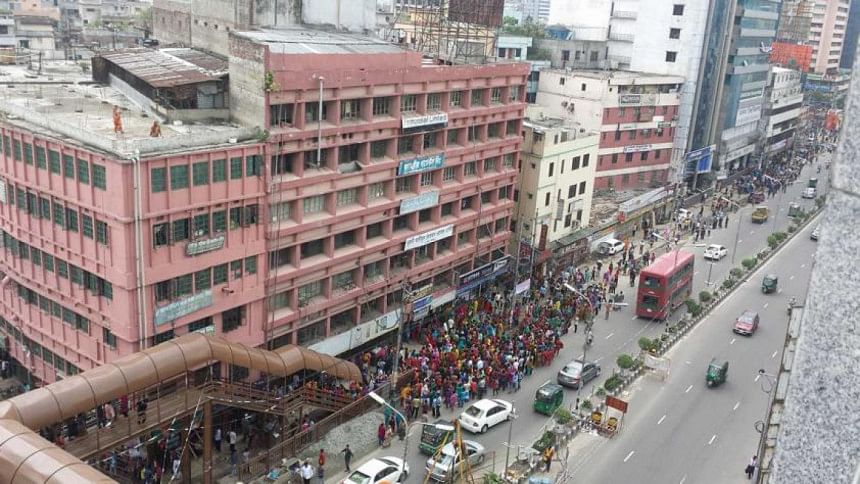Understanding earthquakes in Bangladesh

REMEMBER the early morning of January 4 this year, when we were jolted by an earthquake that scored a 6.7 on the Ritcher scale? Many of us were getting ready to offer our Fazr prayers, when we experienced a violent trembling four or five seconds later. Many rushed out of their house to open grounds while others were in deep slumber. The origin of the earthquake was in Manipur in Northeast India next to the border in Sylhet.
There is a prognostication that a big earthquake is likely to jolt us soon. If this happens, then the moot question is whether we are prepared to face it and come out relatively unscathed. Reports indicate that we may not be as lucky as the last time. Many remain uninformed about what precautions need to be taken. Also, we don't know whether proper rescue operations are in place for people trapped inside buildings in case of a big earthquake. The positive thing is that it can now be said that in the last six to eight years, there has been a greater awareness among the people and our government about a major earthquake. But will it suffice to save lives and properties? The media, including newspapers, journals, TV and the internet are giving much information about earthquake threats, risks, vulnerability, preparations, precautions and rescue programmes. Yet, people in Bangladesh are not as informed about what causes earthquakes or how they can prepare in case of such an eventuality. This is sad, considering that the collapse of one Rana Plaza, and the casualties it incurred still sends shivers down our spines.
We all know that earthquakes occur unevenly on the globe. Yet analyses have shown that destructive earthquakes occur in two well-defined zones in the world. First is around the Pacific Ocean. The second major zone is around the Mediterranean-Himalayan seismic belt. Earthquakes can also occur along large cracks in the Earth's crust. Deep inside the centre of the Earth, intense heat and rocks melt to form magma, which then moves through cracks to the Earth's crust in order to cool. But on its way to the top, the magma moves to those parts of the crust that is weak. It moves in the form of a plate, and as the plate moves, it can meet another plate and one of them will be pushed down into the earth. In another case, plates can be compressed, pushing up to form hills or mountains.
Bangladesh is located along the Indian and Eurasian plates. So when the Indian plate moves northward and meets the Euro Asian plate, earthquakes can occur. In fact, the Indian plate is moving around 6mm each year towards the northeast and goes under the Euro Asian plate. Then there is the Myanmar fault along the northern and eastern parts of Bangladesh. There is also a 300 km long Dauki fault along the Meghalaya-Bangladesh border as well as a 150 km long Madhupur fault and a 300km fault which runs along the Surma basin. Finally, we have the Chittagong-Myanmar plate close to the Bay of Bengal. This cluster of faults in Bangladesh often causes mild to moderate earthquakes. Ever since earthquake records have been compiled in this part of South Asia, seven strong earthquakes have hit us. In 1869, an earthquake scoring 7.5 on the Richter scale occurred 250 miles from Dhaka. The Great Indian earthquake, scoring 8.7 on the Richter scale was 230 miles from Dhaka. The last great earthquake, the Assam earthquake, which scored 8.5 on the Richter scale, occurred in 1950, and was 780 miles from Dhaka.
The big question now is how prepared are we for a moderate to major earthquake? Have we taken necessary steps to reduce damages when the next big earthquake hits Dhaka? While it is difficult to predict when the next big one will strike, we should take steps to contain the deaths and destruction before it eventually hits us.
We already know that the tectonic framework of Bangladesh is such that we are a seismic active country. The Indian plate is creeping 6mm each year towards the northeast. At times, it moves under the Euro Asian plate and the Myanmar plate. This poses great risks to the high-rise buildings of Dhaka and Chittagong. It also poses a threat to the flood protection embankments due to the liquefaction effect which could cause sudden sinking of large areas close to big rivers. Big earthquakes could cause huge fires from the breakdown of natural gas lines. There could be large scale power cuts and disruption of water connections.
According to geologists, three zones in Bangladesh are susceptible to earthquakes. The Sylhet-Mymensingh areas, and areas around Chittagong, Dhaka, Comilla and Tangail are especially vulnerable to large scale earthquakes when compared to the rest of Bangladesh. But around one-third of Dhaka city itself could be severely damaged in case of a big earthquake. Buildings in Old Dhaka are most vulnerable because of their age and also because they are not necessarily built with strong materials. In fact, Dhaka has been marked as one of the 20 cities most vulnerable to earthquakes in the world.
In order to be prepared to face eventualities, it is necessary to draw an earthquake vulnerability map of Dhaka. We also need to ensure that future buildings follow the building code. People in general should be tutored about possible ground motions when an earthquake occurs. Building insurance schemes must be introduced to initiate earthquake resistant construction. The government should take initiatives to introduce automatic safety shutdown systems in all gas and electricity connections to prevent fires and electrocution after earthquakes. Post-earthquake rescue and recovery as well as hospital services should be in place for victims of earthquakes.
Needless to say, Bangladesh has always been able to mitigate effects of large scale natural disasters like floods and cyclones. We now need to put a massive earthquake rescue and mitigation programme in place. The government, NGOs, teachers and volunteer organisations should join hands to put such a programme in place. The most modern equipments should be made available and widespread training of volunteers should be organised. Citizens of the country expect this to take place without any hindrance.
The writer is a former ambassador and columnist.
E-mail:[email protected]

 For all latest news, follow The Daily Star's Google News channel.
For all latest news, follow The Daily Star's Google News channel. 



Comments